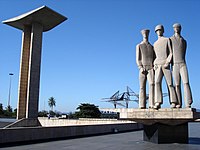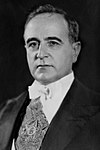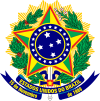Brazilian Expeditionary Force
| Brazilian Expeditionary Force | |
|---|---|
| Força Expedicionária Brasileira | |
 Brazilian Expeditionary Force shoulder sleeve insignia (Army component) with a
smoking snake | |
| Active | 1942–1945 |
| Country | |
| Allegiance | United Nations |
| Branch | Brazilian Army Brazilian Air Force |
| Type | Expeditionary Force |
| Role | Aerial warfare Combined arms Expeditionary warfare |
| Size | 25,900 |
| Engagements | |
| Commanders | |
| Notable commanders | Mascarenhas de Moraes,General Commander
Olympio Falconiere da Cunha, General Inspector Euclidés Zenóbio da Costa, Divisional Infantry Commander Oswaldo Cordeiro de Farias, Divisional Artillery Commander |
TheBrazilian Expeditionary Force(Portuguese:Força Expedicionária Brasileira,FEB), nicknamedCobras Fumantes(literally "theSmoking Snakes"),[1]was amilitary divisionof theBrazilian ArmyandAir Forcethat fought as part ofAlliedforces in theMediterranean TheatreofWorld War II.It numbered around 25,900 men, including a fullinfantrydivision,liaisonflight,andfightersquadron.[2]
Placed underUnited States command,Brazilian troops fought primarily in theliberation of Italyfrom September 1944 to May 1945, while theBrazilian Navyand Air Force took part in theBattle of the Atlanticfrom mid-1942 until the end of the war.[1]The FEB operated mostly at theplatoon level,[3]seeing heavy combat at the arduousGothic Lineand during the1945 final offensive.By the end of the war, it took 20,573 Axisprisoners,including twogeneralsand close to 900officers.The division lost 948 menkilled in actionacross all three services.[4][2]
Vargas eraBrazil was the only independent South American country to send combat troops overseas during the Second World War.[1]Known for its tenacity and bravery, the FEB was well-regarded by both allies and adversaries; it served with distinction in several battles, most notably atCollecchio,Camaiore, Monte Prano, and Serchio Valley.[1]Brazil's navy and air force played important roles in protecting Allied shipping and crippling Axis maritime power, inflicting disproportionately high losses on enemy munitions, supplies, and infrastructure.[1]
Overview[edit]
Brazil's participation in World War II on theAlliedside was not a foregone conclusion. Although it had supported theTriple EntenteinWorld War I—as had now-Axis-aligned Japan and Romania—the country'scontribution to the wartook place in its waning years and was primarily naval, although it also sent a small military mission to theWestern Front.In the years leading up to World War II, Brazil was the biggest non-European consumer of German products and ranked ninth among Germany's trading partners overall. It also hosted a large and influential German community that engendered closer ties to Germany.
As in 1914, Brazil in 1939 maintained a position of neutrality, initially trading with both Allied andAxis countries.As the war progressed, trade with the Axis became subject to British and U.S. diplomatic and economic pressure. These efforts included the creation of theJoint Brazil-U.S. Defense Commission,chaired byU.S. ArmyMajor GeneralJames Garesche Ord,which was broadly aimed at strengthening military ties between the countries; however, its central goal was to reduce the likelihood of Axis attacks on U.S. shipping across the Atlantic and minimize Axis influence in South America.[5]
Although Brazil was officially neutral, it increasingly cooperated with the Allies, particularly the U.S., shortly after the latter enteredWorld War IIin December 1941. ThePan American States Conference,which took place inRio de Janeirofrom 15–28 January 1942, was convened in the wake of the U.S. declaration of war against the Axis powers. The meeting centered on U.S. offers of economic assistance to Latin America countries in return for security cooperation and the severing of diplomatic ties withAxis members;Brazil consequently ended diplomatic relations with Germany, Japan, and Italy by the end of January.[6]
Pursuant to the conference, Brazil permitted the U.S. to set up air bases on its territory in return for assistance in developing a domestic steel industry,Companhia Siderúrgica Nacional,which would serve the American war effort and afterwards benefit the Brazilian economy. The bases were located in the north-central states ofBahia,Pernambuco,andRio Grande do Norte,where the city ofNatalhosted part of the U.S. Navy'sVP-52bombing squadron, later becoming the largest overseas U.S. airbase. Brazil also hosted U.S. Task Force 3, which included a squadron equipped to attack submarines and merchant vessels attempting to trade with Japan.
Nevertheless,unlike in 1917,the Brazilian government sought to avoid war and instead maintain economically beneficial ties with both sides.[7]Notwithstanding its formal neutrality and reticence to declare war, Brazil's cooperation with the U.S. and break in diplomatic relations prompted immediate German reprisals. From the end of January to August 1942, GermanU-boatssank 18 Brazilian merchant vessels; the spate of attacks was especially severe after June 16, when Hitler personally called for a "submarine blitz" against Brazil, having considered its closer ties with the U.S. to be tantamount to an act of war.[8]By mid-August, the Germans were targeting shipping closer to Brazil's coast;U-507alone sank five Brazilian vessels in two days, causing more than 600 deaths:[9]
- On August 15, theBaependi,traveling fromSalvadortoRecife,was torpedoed at 19:12. Its 215 passengers and 55 crew members were lost.
- Less than an hour later,U-507torpedoed theAraraquara,also traveling from Salvador towards the north of the country. Of the 142 people on board, 131 died.
- Seven hours after the second attack, theAnníbal Benévolowas attacked, killing all 83 passengers and all but four of its 71 crew.
- On August 17, close to the city ofVitória,theItagibawas hit at 10:45, resulting in 36 deaths.
- Another Brazilian ship, theArará,traveling from Salvador toSantos,was targeted as it stopped to help the crippledItagiba,suffering 20 fatalities.
In all, 21 German and two Italian submarines sank 36 Brazilian merchant ships, resulting in the deaths of nearly 2,000 people. The wave of August attacks proved to be a breaking point, especially since the victims included army soldiers and religious pilgrims. Brazil "erupted in a wave of revulsions" as anti-Axis demonstrations, some of them violent, spread across most major cities, including Rio de Janeiro. Protestors burned the flags of the Axis powers and chanted "We want war!"; in some cases, German communities were harassed.[10]The passive position of the Vargas government proved untenable in the face of public opinion, and on August 22, within a week of the last U-boat attack, the Brazilian cabinet approved a declaration of war against the Axis nations.[11]

Although Brazil continued to provide much needed supplies, war material, and strategic territory for foreign bases, the decision to contribute troops came several months later, at thePotenji River Conferenceof 28 and 29 January 1943. Held inNatal, Rio Grande do Norteaboard theUSSHumboldt,the meeting between U.S. PresidentFranklin D. RooseveltandGetúlio Vargasresulted in greater political, economic, and military cooperation between the U.S. and Brazil, including invitations for the latter to play a larger role in the postwar global order. Vargas and Foreign MinisterOswaldo Aranhasaw the commitment of soldiers as a means of solidifying the strategic partnership with the U.S., and of enhancing Brazilian prestige and influence on the global stage.
[edit]
The participation of theBrazilian Navyin World War II was not directly connected to the FEB and the Italian Campaign, as it was largely engaged in theBattle of the Atlantic.Axis naval attacks caused nearly 1,600 deaths, which included 500 civilians, 470 merchant seamen, and 570 sailors of the Navy; roughly one in seven Brazilian sailors would perish in the campaign. A total of 36 ships were sunk by the Germans, with an additional three lost (and 350 killed) in accidental sinkings.[12]
The main task of the Brazilian Navy was, together with the Allies, to ensure the safety of ships sailing between the central andsouth AtlantictoGibraltar.Alone or in coordination with Allied forces, it escorted 614convoysthat protected 3,164 merchant and transport troop ship.[13]In the battle against German submarines, Brazilianfrigatesandsubmarinesusedminesanddepth charges.According to German documents, the Brazilian Navy attacked German submarines a total of 66 times.
The Brazilian Navy is confirmed to have destroyed twelve Axis submarines along its coasts: theItalian submarineArchimedeand the GermanU-128,U-161,U-164,U-199,U-507,U-513,U-590,U-591,U-598,U-604andU-662.[14][15][16]
Among the warships lost by the Brazilian Navy were theminelayerBZCamaqua,which capsized during a storm while escorting a convoy in July 1944, and the light cruiserBZBahiadue to a gunnery accident;[17][18]the majority of the latter's crew were lost.[19]Of the three Brazilian military ships lost during the war, only thefreighter-troopshipVital de Oliveirawas due to the action of an enemy submarine, being sunk by theU-861on July 20, 1944.[20]
By the end of the war, the entirety of the South Atlantic convoy had been turned over to the Brazilian Navy, thereby relieving American and British vessels for urgently needed service elsewhere.[21]
Brazilian fleet during World War II[edit]
| Class | Boat | Displacement | Type | Origin | Note | Photo |
|---|---|---|---|---|---|---|
| Minas Geraes-class battleship | Minas Geraes São Paulo |
20,900 tons | Dreadnoughtbattleship | 
| ||
| Bahia-class cruiser | Bahia Rio Grande do Sul |
3,100 tonnes | Scout cruiser | 
| ||
| Marcílio Dias-class destroyer | M1Marcílio Dias M2Mariz e Barros M3Greenhalgh |
1,900 tonnes | Destroyer | 
| ||
| Acasta-class destroyer | Maranhão | 950 tonnes | Destroyer | 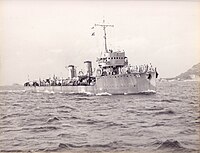
| ||
| Pará-class destroyer | Piauí Mato Grosso Rio Grande do Norte Paraíba Santa Catarina Sergipe |
570 tonnes | Destroyer | 
| ||
| Cannon-class destroyer | Babitonga Baependi Benevente Beberibe Bocaina Bauru Bertioga Bracui |
1,500 tonnes | Destroyer escort | 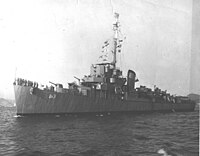
| ||
| Carioca-class corvette | C1Carioca C2Cananéia C3Camocim C4Cabedelo C5Caravelas C6Camaquã |
818 tonnes | Corvette | 
| ||
| Pernambuco-class Monitor | Pernambuco Paraguassú |
650 tonnes | Gunboat | 
| ||
| PC461-class submarine chaser | G1Guaporé G2Gurupi G3Guaíba G4Guarupá G5Guajará G6Goiânia G7Grajaú G8Graúna |
450 tonnes | Submarine chaser/patrol boat | 
| ||
| Tupy-class submarine | S11Tupy S12Tymbira S13Tamoyo |
1,450 tonnes | Submarine | |||
| Humayta-class submarine | Humaytá | 1,900 tonnes | Submarine | 
|
Command[edit]

The Brazilian 1st Division of the FEB was subordinate to theAllied 15th Army Groupunder Field MarshalHarold Alexander(later succeeded by GeneralMark Clark), via theUS Fifth Armyof Lieutenant General Mark Clark (later succeeded by Lieutenant GeneralLucian Truscott) and theUS IV Corpsof Major GeneralWillis D. Crittenberger.The entry for theGothic Line order of battleprovides the layout for the Allied and German armies in Italy.
FEB headquarters functioned as an administrative headquarters and link to the Brazilianhigh commandunder the secretary of war, GeneralEurico Gaspar Dutrain Rio de Janeiro. GeneralMascarenhas de Morais(later marshal) was the commander of the FEB, with General Zenóbio da Costa as chief of the 6thRegimental Combat Team (RCT)ofCaçapava(the first FEB RCT to land in Italy), and General Cordeiro de Farias as commander of artillery.
Theoretically, the FEB was organized as a standard U.S. infantry division of that time, complete in all aspects, down to itslogistical tail(including postal and banking services), although some of these, like itshealth services,were found to be deficient and had to be complemented, and in many cases controlled or managed by Americans.[22][23]Its combat units were, besides the aforementioned 6th RCT, the 1st RCT based in Rio de Janeiro, and the 11th fromSão João del Rei.Each RCT had about 5,000 men (corresponding in size to todaybrigades), divided in three then called "battalions" consisting of fourcompanieseach, includingsupporting units for combat,andother army branches,likeartillery,engineering,andcavalry.[24]The Brazilian Air Force Fighter squadron was itself under the Mediterranean Allied Tactical Air Force.[25]
Campaign[edit]
Preparations[edit]
Soon after Brazil declared war on the Axis, it began a popularmobilizationfor an expeditionary force to fight in Europe.[26][27]At that time, Brazil was a country with a traditionally isolationist foreign policy. Its population was largely rural and illiterate, its economy focused onexportingcommodities,and it lackedinfrastructureinindustry,health care,andeducation,which was needed to support thewar effortwith material and human resources. Further, an action plan to circumvent these limitations (like theCalogeras Planof the previous World War) was out of the question because many Brazilian military officers believed that a Nazi-Fascist defeat in Europe would increase demands for democracy within Brazil. At the time, Brazil had a military regime. It had been openly authoritarian from 1937 and sympathetic to Nazi-fascist regimes until 1941. Brazil was thus precluded from pursuing a line of autonomous action in the conflict, and found it difficult to take even a modest role in it.
Faced with the government's passivity and unwillingness,Assis Chateaubriand,a mass media magnate, negotiated with US officials stationed in Brazil, for the creation of an expeditionary army division, composed of volunteers from all ofLatin America.This division would be financed by him, led by a Brazilian general, and trained by American officials. This initiative was curtailed by the Brazilian government in early 1943.[28]
Almost two years later, Brazil officially entered the war and sent troops to theEuropean Theater of Operations.For comparison, the gap between the US's entrance andOperation Torchwas almost one year. Several reasons contributed to the delay: political distrust between the Brazilian and American authorities, disagreements over the target size of the Brazilian Expeditionary Force, differences between Brazilian aspirations and American preferences for controlling the force, and disagreements on whether it should be fully trained and armed before boarding or get stationed behind theItalian Frontand train there.[29]
In the end, the Brazilian government gathered a force of oneArmyDivisionof 25,000 men (replacements included), compared with an initial declared goal of a whole ArmyCorpsof 100,000, to join the Allies in theItalian Campaign.[30]
Arrival in Italy[edit]
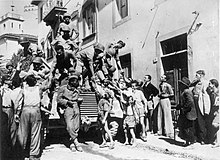
On July 2, 1944, the first 5,000 FEB soldiers, the 6th RCT, left Brazil for Europe aboard theUSSGeneral Mann,reachingNaples, Italyon July 16. Lacking weapons, equipment, and even an arrangement forbarracks,they remained on the docks while waiting to join the U.S. Task Force 45. The poor planning and subsequent embarrassment aroused controversy in Brazilian media.[31]In late July, two moretransportswith Brazilian troops reached Italy, with three more following in September and November 1944, and February 1945. One notable unit deployed was Brazil'sMountain Infantry Battalion.
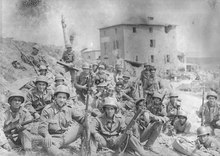
The FEB dedicated its first weeks in Italy to acquiring the proper equipment to fight on Italian terrain, and to training under American command.[32]The preparation in Brazil, despite the two years' interval since the declaration of war, had proved almost worthless. Among the veterans of that campaign, there was a consensus that onlycombatcould adequately prepare the soldier, regardless of the quality of training received earlier.[33][34]In August, the troops moved toTarquinia,350 km north ofNaples,where Clark's army was based. In November, the FEB joinedGeneral Crittenberger'sUS IV Corps.
The Brazilians joined amultinational hodgepodge of soldiers.American forces included the segregated African-American92nd Infantry Divisionand the Japanese-American442nd Infantry Regiment.British forces drew from across the empire, includingAustralia,New Zealand,Canada,India,Nepal,Mandatory Palestine,South Africa, Rhodesia,and various African colonies. Also under British command were soldiers from occupied countries such asPoland,Greece,and Czechoslovakia, as well as anti-fascist Italians.Free French forcesincluded Senegalese,MoroccansandAlgerians.[35][36][37]
The Germans made much of the political aspect of Brazil's presence in Italy; propaganda was targeted specifically at Brazilians, in the form of leaflets and a Portuguese-language, hour-long daily radio broadcast from Berlin Radio calledHora AuriVerde(GoldenGreen Hour).[38]
Combat[edit]
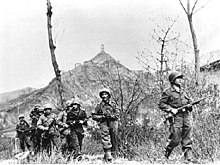

The FEB achieved battlefield successes atMassarosa,Camaiore,Mount Prano, Monte Acuto, San Quirico,Gallicano,Barga,Monte Castello,La Serra, Castelnuovo diVergato,Soprassasso,Montese,Paravento,Zocca,Marano sul Panaro,CollecchioandFornovo di Taro.[39]

The first missions the Brazilians undertook in close connection with theUS 370th Infantry Regiment,werereconnaissanceoperations to the end of August. Brazilian troops helped to partially fill the gap left by divisions of theUS VI CorpsandFrench Expeditionary Corpsthat left Italy forOperation Dragoon,the invasion of southern France. On September 16, the 6th RCT took Massarosa. Two days later it also took Camaiore and other small towns on the way north. By then, the FEB had already conquered Monte Prano, and taken control of theSerchiovalley without any major casualties. After having suffered its first reverses aroundBargacity, and after the arrival of the 1st RCT at the end of October, the FEB was directed to the base of thenorthern Apennines,on the border betweenTuscanyandEmilia-Romagnaregions, where it would spend the next months facing the harsh winter and the resistance of theGothic Line.[40]Allied forces were unable to break through the mountains over the winter andan offensiveby German and Italian divisions to the left of the FEB sector, against the US 92nd Infantry Division, required the assistance of the8th Indian Infantry Divisionbefore it was repelled.
Between the end of February and the beginning of March 1945, in preparation for theSpring offensive,the Brazilian Division and theU.S. 10th Mountain Divisionwere able to capture important positions in the northern Apennines (noteworthy in the Brazilian sector, for Monte Castello and Castelnuovo), which deprived the Germans of key artillery positions in the mountains, whose effective fire had since the fall of 1944 blocked the Allied path toBologna.[41][42][43]
Frankly, you Brazilians are either crazy or very brave. I never saw anyone advance against machine-guns and well-defended positions with such disregard for life... You are devils— A German captain to a captured FEB lieutenant.[44]
In the US Fifth Army's sector, the final offensive on the Italian Front began on 14 April, after a bombardment of 2,000 artillery pieces; an attack carried out by the troops of US IV Corps led by the Brazilian Division took Montese. After the first day of the Allied offensive, the Germans, without much effort, had stopped the main attack of IV Corps led by the US 10th Mountain Division, causing significant casualties among the troops of that formation. The Germans were misled into thinking that the FEB's raid over Montese, usingM8 armoured carsandSherman Tanks,could be the real main Allied objective in that sector, which led them to shell the Brazilians with 1,800 artillery rounds from the total of 2,800 used against all four Allied divisions in that sector during the days of the battle for Montese,[45]when they tried unsuccessfully to take Montese back from the Brazilians. After that, the breaking of the Germans' lines to the north by forces of IV Corps became unavoidable.[46]On the right, thePolish Division,from theBritish 8th Army,and the US34th Infantry Division,from Fifth Army, entered Bologna on 21 April.
On 25 April theItalian resistance movementstarted a general partisan insurrection at the same time as Brazilian troops arrived atParmaand the Americans atModenaandGenoa.The British 8th Army advanced towardsVeniceandTrieste.
At theBattle of Collecchio,Brazilian forces were preparing to face fierce resistance at theTaro riverregion from the retreating German-Italian forces in the region of Genoa/La Spezia that had been set free by troops of the 92nd US Division. These Axis troops wereenvelopednearFornovoand after some fightingsurrendered.On April 28, the Brazilians captured more than 13,000 men, including the entire148th Infantry Division,elements of the90th Panzergrenadierand the Italian1st Bersaglieri "Italia" Division.[citation needed]
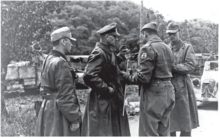
This took the German Command by surprise as it had planned for these troops to join forces with the German-Italian Army of Liguria to counterattack against the Fifth Army. Fifth Army had advanced, as is inevitable in these situations, in a fast but diffuse and disarranged way uncoordinated with air support, and had left some gaps on its left flank and to the rear. The Axis forces had left many bridges intact along thePo Riverto facilitate a counter-attack. German Army Command was already negotiating a truce inCaserta,and hoped that a counterattack would improve the conditions for surrender. The events in Fornovo disrupted the German plan, as much by the disarray of their troops as by the delay it caused.[47]This, added to the news ofAdolf Hitler's death and thetaking of Berlinby theRed Army,left the German Command in Italy with no option but to accept the demand for the unconditional surrender of its troops.
In their final advance, the Brazilians reachedTurinand then on 2 May they joined up with French troops atthe borderinSusa.That same day brought the announcement of the end of hostilities in Italy.
Air force[edit]
1st Fighter Squadron[edit]
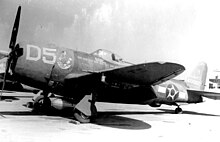


The1st Fighter Aviation Group(1oGAVCA, 1st Fighter Squadron/1º Grupo de Aviação de Caça) was formed on December 18, 1943. Its commanding Officer was Ten.-Cel.-Av. (Aviation Lieutenant Colonel) Nero Moura. The Squadron had 350 men, including 48pilots.It was divided into four flights: Red ( "A" ), Yellow ( "B" ), Blue ( "C" ), and Green ( "D" ). Unlike the FEB's Army component, the 1oGAVCA had personnel who were experiencedBrazilian Air Force(Portuguese: Força Aérea Brasileira, or FAB) pilots. One of them was Alberto M. Torres, who commanded thePBY-5A Catalinathat had sunkU-199(which had been operating off the Brazilian coast).[48]
Among the 48 pilots of the Brazilian Unit who carried out war missions, there was a total of 22 losses; five of the pilots were killed by anti-aircraft fire, eight had their planes shot down and bailed out over enemy territory, six had to give up flying operations on medical orders and three died in flying accidents.
The squadron trained for combat atU.S. basesinPanama,where 2oTen.-Av. (Aviation Second Lieutenant) Dante Isidoro Gastaldoni was killed in a training accident. On May 11, 1944, the squadron was declared operational and became active in the air defense of the Panama Canal Zone. On June 22, the 1oGAVCA traveled to the US to convert to theRepublic P-47D Thunderbolt.[49]

On September 19, 1944 the 1oGAVCA left for Italy, arriving at Livorno on October 6.[49]Since the "Group" arrived at the front with theMinimum Limit Numberof pilots for anAir Group,and there was no prediction of replacements arrival in a forthcoming future, it was attached as a Squadron at the350th Fighter Groupof theUSAAF,which in turn was part of the62nd Fighter Wingof the12th Air Force,into theXXII Tactical Air Command.[50][51]
The Brazilian pilots initially flew from 31 October 1944, as individual elements of flights attached to 350th FG squadrons, at first in affiliation flights and progressively taking part in more dangerous missions. Less than two weeks later, on November 11, the BrazilianSquadronstarted its own operations flying from its base atTarquinia,using its tacticalcallsignJambock.Brazilian Air Force stars replaced the white U.S. star in the roundel on the FAB Thunderbolts. The 1oGAVCA started its fighting career as a fighter-bomber unit, its missions being armed reconnaissance andinterdiction,in support of the U.S. Fifth Army, to which the FEB was attached. On April 16, 1945, theU.S. Fifth Armystarted its offensive along thePo Valley.By then, the strength of the "Group" had fallen to the standard size of an air squadron: 23 pilots, since some had been killed, others shot down and captured, while others had been relieved from their duties on medical grounds due to wounds or combat fatigue.[52]
On 22 April 1945, the three remaining flights took off at five-minute intervals, starting at 8:30 AM, to destroy bridges, barges, and motorized vehicles in the San Benedetto region. At 10:00 AM, a flight took off for an armed reconnaissance mission south ofMantua.They destroyed more than 80 German military vehicles, including tanks. By the end of the day, the Brazilian Squadron had flown 44 individual missions and destroyed a high number of vehicles and barges. On this day Brazilians flew the most sorties of the war; consequently, Brazil commemorates April 22 as 'Brazilian Fighter Arm' Day. The 1st Brazilian Fighter Squadron accomplished 445 missions, with a total of 2,546 flights and 5,465 hours of flight on active service. It destroyed 1,304 motor-vehicles, 13 railway wagons, 8 armoured cars, 25 railway and highway bridges and 31 fuel tanks and munition depots.
In all, the 1oGAVCA flew a total of 445 missions, 2,550 individual sorties, and 5,465 combat flight hours, from November 11, 1944 to May 6, 1945. The XXII Tactical Air Command acknowledged the efficiency of the Brazilian Squadron by noting that although it flew only 5% of the total of missions carried out by all squadrons under its control, it accomplished a much higher percentage of the total destruction wrought:
- 85% of the ammunition depots
- 36% of the fuel depots
- 28% of the bridges (19% damaged)
- 15% of motor vehicles (13% damaged)
- 10% of horse-drawn vehicles (10% damaged)[53]
Total of operations of the First Brazilian Fighter Squadron in the Italy Campaign:
| Missions accomplished | 445 |
| Offensive missions | 2,546 |
| Defensive missions | 4 |
| Hours of flight in war operations | 5,465 |
| Total hours of flight accomplished | 6,144 |
| Total Bombs dropped | 4,442 |
| Incendiary Bombs (F.T.I) | 166 |
| Fragmentation Bombs (260 lbs) | 16 |
| Fragmentation Bombs (90 lbs) | 72 |
| Demolition Bombs (1.000 lbs) | 8 |
| Demolition Bombs (500 lbs) | 4,180 |
| Approximate total tonnage of bombs | 1,010 |
| Rounds of.50 caliber ammunition fired | 1,180,200 |
| Total rockets fired | 850 |
| Liters of gasoline consumed | 4,058,651 |
| Targets/Objectives | Destroyed | Damaged |
|---|---|---|
| Railway engines | 01 | 13 |
| Motorized transport | 470 | 303 |
| Railway and tank cars | 63 | 163 |
| Armored cars | 07 | 11 |
| Animal drawn vehicles | 79 | 19 |
| Railway and highway bridges | 04 | 14 |
| Railway and highway cuttings | 55 | 00 |
| Buildings occupied by the enemy | 129 | 92 |
| Camps occupied by the enemy | 18 | 14 |
| Command posts | 02 | 02 |
| Artillery positions | 43 | 07 |
| Factories | 04 | 03 |
| Miscellaneous buildings | 39 | 04 |
| Fuel depots | 06 | 02 |
| Refineries | 01 | 01 |
| Radar stations | 00 | 02 |
On April 22, 1986, the 1st Fighter "Group" of the Brazilian Air Force was awarded the United StatesPresidential Unit Citationfor its actions in the Po Valley region of Italy in World War II.[54]
1st Liaison & Observer Flight[edit]
In contrast to the 1st Fight Squadron, which was an Air Force unit that operated in support of the army, the 1st "Liaison & Observer Flight" (Portuguese acronym:E.L.O.) was directly under the command of the FEB.[55]Formed in late July 1944, the 1stE.L.O.consisted of reservist officers, namely Air Force pilots and Armyartillery observers,who flew together aboardPiper L-4H Cubs.This air unit accompanied the Brazilian division throughout its Italian campaign.[50]
Aftermath[edit]
The FEB participated in the post-war occupation ofPiacenza,Lodi,andAlessandria.U.S. leaders wished for Brazilian troops to take part in the Allied occupation of Europe, but in early June 1945, Brazil's secretary of war ordered that the unit be subordinate to the commander of the first military region in Rio de Janeiro; it was recalled to Brazil by the end of 1945 and, amid U.S. objections, was dissolved as a distinct military formation.[56]
Hundreds of Brazilians who perished in the final offensive were buried in theFEB cemetery in Pistoia.At the urging of MarshalMascarenhas de Moraes,a new mausoleum was constructed in Rio de Janeiro for all military deaths in the war; in 1960, the cemetery was closed and the remains were officially interred with other Brazilian war dead in the newNational Monument to the Dead of World War II.Shortly afterward, a body was found remaining in the former cemetery, and the Brazilian government inaugurated a newTomb of the Unknown Soldieron the site in 1967.
Brazil's participation in World War II was more extensive than in any foreign conflict outside its region. Its main contribution was to the south Atlantic campaign, which was described by U.S. rear admiralSamuel E. Morisonas decisive to Allied victory.[57]However, sending a ground force overseas had more political and social visibility, elevating the country's global stature and evoking national pride. The FEB was one of about 30 Allied military formations (20 divisions and 10 brigades) on the Italian Front at that time. Although it played an important part in the sectors where it operated, Brazil's role was largely tactical, and it never had a major impact on a strategic level.[58]Furthermore, the Italian Front became secondary for both sides afterthe Normandy landingsin June 1944 and theinvasion of southern Francethat August. Nevertheless, the FEB was viewed by contemporaries as a largely effective fighting force, which "completed all the missions confided to it and compared favorably with the American divisions of the Fourth Corps."[59]
Nickname[edit]

Due to the Brazilian regime's unwillingness to get more deeply involved in the Allied war effort, by early 1943 a popular saying was: "Mais provável uma cobra fumar um cachimbo, do que a FEB ir para a frente da luta" (literally: "It's more likely for a snake to smoke a pipe than for the FEB to go the front and fight" ).[60][note 1]Before the FEB entered combat, the expression "a cobra vai fumar" ( "the snake will smoke" ) was often used in Brazil in a context similar to "when pigs fly";soldiers in the division subsequently called themselvesCobras Fumantes(literally,Smoking Snakes) and wore a shoulder patch depicting a green snake smoking a pipe. It was also common for Brazilian soldiers to write on their mortars, "A Cobra Está Fumando..." (literally: "The Snake Is Smoking..." ).[citation needed]After the war the meaning was reversed, signifying that something will definitively happen in a furious and worse way. With that second meaning the use of the expression "A Cobra Vai Fumar!" (literally: "The Snake Will Smoke!" ) has been retained in Brazilian Portuguese until the present.
See also[edit]
- Brazil in World War II
- Atlantic naval campaign (World War II)
- Brazil at War– American propaganda film about the Brazilian contribution.
- Battle of Monte Castello
- Battle of Collecchio
- Brazil during World War I
- Elza Medeiros– a Brazilian major, she was the highest-ranking female officer in the FEB.
- Max Wolff– A Brazilian war hero from the FEB.
- Mexican Expeditionary Air Force
Footnotes[edit]
- ^Portuguese:Mais fácil uma cobra fumar um cachimbo, do que a FEB embarcar para o combate.
Notes[edit]
- ^abcdeStilwell, Blake."Why Brazilian troops had the best unit patch of World War II".Business Insider.RetrievedOctober 22,2021.
- ^abIbidem Maximiano, Bonalume, Ricardo N. & Bujeiro, 2011.
- ^Frank D. McCann, "Brazil and World War II: The Forgotten Ally. What did you do in the war, Ze Carioca?"University of New Hampshire,p. 61.
- ^Frank D. MacCann – 'Estudios Interdisciplinarios de America Latina y el Caribe', vol. 6, No. 2, 1995.
- ^Stetson Conn, Byron Fairchild,Office of the Chief of Military History,Department of the Army,The Framework of Hemisphere Defense,1960, p. 319
- ^"Avalon Project – A Decade of American Foreign Policy 1941–1949 – Havana Meeting of Ministers of Foreign Affairs of the American Republics, July 21–30, 1940".Avalon.law.yale.edu.Retrieved 2016-09-10
- ^Jefferson Caffery to Cordell Hull, Rio, April 22, 1939, 832.00/1255, RG59, National Archives (NA) Washington.
- ^McCann, Frank D. (January 1, 1995)."Brazil and World War II The Forgotten Ally. What did you do in the war, Zé Carioca".Estudios Interdisciplinarios de América Latina y el Caribe.6(2).ISSN0792-7061.
- ^VEJA Edição Especial – O Brasil na GuerraArchivedDecember 5, 2013, at theWayback Machine
- ^Hélio Silva, "1942 Guerra no Continente"
- ^McCann, Frank D. (January 1, 1995). "Brazil and World War II The Forgotten Ally. What did you do in the war, Zé Carioca".Estudios Interdisciplinarios de América Latina y el Caribe.6(2).ISSN0792-7061.
- ^Relação de navios brasileiros afundados[permanent dead link]
- ^Votaw: 1950, pp. 10579ff. 1951, p. 93.
- ^Heden, 2006. Pages: 58 (6, Wed.), 59 (13, Wed.), 64 (15, Thu.), 66 (17, Mon.), 70 (9, Fri.), 72–73 (19, Mon), 74 (30, Fri. and 31, Sat.); Chapters 6 (German Submarine Losses) & 7 (Italian Submarine Losses).
- ^Several, James L. p. 17, section "1.16.5 Brazil".
- ^Barone, 2013. Chapter 2 (final).
- ^"Allied War Losses".u-boat.net.RetrievedMay 20,2015.
- ^Bonalume, 1995. p. 216.
- ^"BZ Bahia (C 12)".u-boat.net.RetrievedMay 20,2015.
- ^Rohwer, 1999. p. 183.
- ^The Brazilian Navy in World War II | Proceedings - May 1950 Vol. 76/5/567(usni.org)
- ^Several authors, 1949. Pages 294; 394; 414–15.
- ^Due to the strongsexismin Brazilian society at that time, the participation of women in the FEB was not viewed favorably by the authorities, being discouraged officially and unofficially, even behind the lines in logistics services, in key sectors such asmilitary nursing.In this area there was a boycott attempt, not only by male Brazilian military doctors, but also by women who were in a position of influence in national politics; SeeMoser, 2009,Page 141.
- ^Concerning the cavalry, it is important to highlight that this Army branch (whether in the form of larger formations, such as Army divisions Or smaller – as in the case of FEB, small supporting units attached to infantry divisions), in all armies during that conflict, was not restricted to its heavy mechanized use, as witharmored carsandtanks.Not only, but especially inmountainous terrain,as was mostly the Italian front, the use of animals, such as themule(among others) and smaller vehicles like militarybicyclesandmotorcycles,were critical to the mobility of troops. More on this topic can be seen in:Nafziger 2000,andWorley 2006(Page 85).
- ^Maximiano, Bonalume & Bujeiro 2011. Page 36
- ^Fernando Morais; "Chatô, rei do Brasil" (Chatô, the 'king' of Brazil)(in Portuguese)Cia das Letras, 1994ISBN8571643962
- ^Silva, Hélio, "1944 o Brasil na Guerra"
- ^Ibidem Morais 1994, pp. 431 to 434
- ^Lochery, 2014. Parts 4 and 5; Chapters 12-16.
- ^"The United States News" U.S. News Publishing Corporation, 1944. Volume 16, Issues 14–26 – Page 52
- ^Command Magazine issue 51, page 34
- ^Frank Marcio de Oliveira "Attaché Extraordinaire:Vernon A. Waltersin Brazil "National Defense Intelligence College2009ISBN9781932946222page 10, 2nd paragraph
- ^Maximiano, 2010. Chapter 5, pg 222 to 1st paragraph of page 223
- ^About the same subject, see also:Dave Grossman."On Killing"&On Combat,as well asIshmael Beah"A Long Way Gone: Memoirs of a Boy Soldier"from his" enlistment "on page 105 to his formal ending of combat detoxification, page 181
- ^Corrigan, Gordon "The Second World War" Thomas Dunne Books, 2011ISBN9780312577094Page 523
- ^Ready, J.Lee, "Forgotten Allies: The European theatre" McFarland, 1985ISBN089950129XPages 152–53, 438.
- ^O'Reilly, Charles T. "Forgotten Battles: Italy's War of Liberation, 1943–1945" Le xing ton Books 2001ISBN0739101951Page 118, 3rd §
- ^"Propaganda leaflets of World War 2: Italian theater of operations/Po Valley Campaign".Archived fromthe originalon April 29, 2018.RetrievedNovember 8,2014.
- ^Edwards, 2010. Page 89.
- ^R.Brooks,The War North of Rome,p.220 to 224
- ^Baumgardner, 1998. Pages 26 to 32.
- ^Bohmler, 1964. End of Chapter IX
- ^Clark, 1950/2007, p.608
- ^Emilio Varoli, "Aventuras de um prisoneiro na Alemanha Nazista," in Depoimento de Oficiais da Reserva Sohre a F.E.B., p. 447.
- ^Dennison de Oliveira, "Os soldados alemães de Vargas" Portuguese [ Germans against Hitler; "The German soldiers of Vargas" ] 1st Chapter, Jurua print. 2008ISBN85-362-2076-7
- ^Willis D. Crittenberger"The final campaign across Italy"; 1952ISBN85-7011-219-X
- ^Ibidem. Bohmler, 1964.
- ^Ibidem Maximiano, Bonalume & Bujeiro 2011. P. 35-36.
- ^abDias de Cunha, Rudnei."Republic P-47 Thunderbolt".rudnei.cunha.nom.br.Archived fromthe originalon February 23, 2019.RetrievedFebruary 23,2019.
- ^abIbidem Maximiano, Bonalume & Bujeiro 2011.
- ^Buyers, 2004. P.98-99.
- ^Buyers, 2004. P.391
- ^Ibidem Buyers, 2004.
- ^"Sinopse e Créditos".December 10, 2004. Archived fromthe originalon December 10, 2004.RetrievedSeptember 28,2018.
- ^Maximiano, Bonalume & Bujeiro 2011. P.12, 17 & 35.
- ^Moraes, 1966. Last Chapter
- ^Samuel Eliot Morison, The Battle of the Atlantic, 1939-1943 (Boston, 1964), p. 376. For the Brazilian navy, see Dino Willy Cozza, "A Marinha do Brasil na II Grande Guerra," Revista do Exercito Brasileiro, Vol. 131, No.3 (Jul./Set. 1994), pp. 64-66; Herbert Campbell, "A Marinha Mercante ea II Grande Guerra," ibid., pp. 71-77. Campbell provides a listing and data on the ships sunk.
- ^loriano de Lima Brayner, A Verdade Sohre a FEB: Mem6rias de um Chefe de Estado�Maior, na Campanha da Italia, 1943- 1945 (Rio de Janeiro: Ed. Civilizayiio Brasileira, 1968), p. 234
- ^FRANK D. McCANN,Brazil and World War II: The Forgotten Ally. What did you do in the war, Zé Carioca?University of New Hampshire.
- ^(in Portuguese)FEB's participation in World War IIArchivedSeptember 27, 2007, at theWayback Machine.Brazilian ArmyRetrieved July 31, 2007
Bibliography[edit]
- Barone, João.1942: O Brasil e sua guerra quase desconhecida (1942: Brazil and its almost forgotten war)(in Portuguese), Rio de Janeiro, 2013.ISBN8520933947
- Baumgardner, Randy W.10th Mountain Division.Turner Publishing Company,ISBN978-1-56311-430-4
- Bohmler, Rudolf (1964).Monte Cassino: a German View.Cassell.ASINB000MMKAYM.
- Brooks, Thomas R.The War North of Rome (June 1944 – May 1945).Da Capo Press, 2003.ISBN978-0-306-81256-9.
- Buyers, John.História dos 350th fighter group da Força Aérea Americana(in Portuguese). UFAL–Universidade Federal de Alagoas, 2004.ISBN978-85-7177-322-6.
- Calikevstz, Viviane Regina. "'Categoria especial da sociedade': estudo do patrimônio cultural e da representatividade social da Força Expedicionária Brasileira – FEB" ('Special category of the society': a study of cultural heritage and social representativeness of the Brazilian Expeditionary Force – FEB) (in Portuguese) PhD thesis in Geography - State University of Ponta Grossa, PR, 2017 <http:// portalfeb.br/wp-content/uploads/Tese-Final-pronta-entregue-a-biblioteca.pdfArchivedAugust 30, 2018, at theWayback Machine>
- Castro, Celso with Vitor Izecksohn and Hendrik Kraay.Nova História Militar Brasileira.Chapters 13 & 14 (in Portuguese). FGV-Fundação Getúlio Vargas, 2004.ISBN85-225-0496-2.
- Clark, Mark Wayne.Calculated RiskNew York: Enigma Books, 1950, republished 2007.ISBN978-1-929631-59-9.
- Crittenberger, Willis D.The final campaign across Italy;year of edition(in English)1952.ISBN857011219Xof 1997 reprint(in Portuguese)
- Edwards, Paul M."Between the Lines of World War II: Twenty-One Remarkable People and Events"McFarland & Co. Inc. Publishers 2010ISBN9780786446674.Chapter 9 "The Smoking Cobras".
- Giannasi, Andrea."Il Brasile in guerra; La partecipazione della Força Expedicionaria Brasileira alla Campagna d'Italia (1944–1945)"(in Italian)Prospettiva editrice (Civitavecchia-Roma) 2004.ISBN88-7418-284-8
- Heden, Karl E.Sunken Ships, World War IIBranden Books, 2006.ISBN0828321183
- Maximiano, Cesar Campiani.Barbudos, Sujos & Fatigados; Soldados Brasileiros na II Guerra Mundial(Bearded, Dirty & Tired; Brazilian soldiers in World War II) (in Portuguese); Grua Livros, 2010.ISBN85-61578-13-0.
- Maximiano, Cesar. with Bonalume, Ricardo N. & Bujeiro, Ramiro.Brazilian Expeditionary Force in World War II[permanent dead link].Osprey Publishing Ltd., 2011.ISBN9781849084833(Print version).
- Moraes, Mascarenhas de.,The Brazilian Expeditionary Force, By Its CommanderUS Government Printing Office, 1966.ASINB000PIBXCG
- Morais, Fernando.Chatô, o Rei do Brasil('Chatô, The King of Brazil') (in Portuguese). Cia das Letras, 1994.ISBN85-7164-396-2.
- Morison, Samuel Eliot "History of United States Naval Operations in World War II: The Battle of the Atlantic; September 1939–May 1943" Little Brown, 1947.ISBN0252069633
- Lochery, Neill.Brazil: The Fortunes of War, War II and the Making of Modern BrazilBasic Books, 2014ISBN9780465039982
- Neto, Ricardo Bonalume.A nossa Segunda Guerra: os brasileiros em combate, 1942–1945(in Portuguese)Expressão e Cultura, 1995.ISBN9788520801918
- Ready, J. Lee.Forgotten Allies: The European Theatre, Volume I.McFarland & Company, 1985.ISBN978-0-89950-129-1.
- Ready, J. Lee.Forgotten Allies: The Military Contribution of the Colonies, Exiled Governments and Lesser Powers to the Allied Victory in World War II.McFarland & Company, 1985.ISBN978-0-89950-117-8.
- Rohwer, Jürgen.Axis submarine successes of World War Two: German, Italian, and Japanese submarine successes, 1939–1945Greenhill Books, 1999.ISBN1853673404
- Several authors;Depoimento de Oficiais da Reserva sobre a F.E.B.( "Testimony of Reserve Officers on Brazilian Expeditionary Division" ),(in Portuguese)Editora Cobraci, 1949
- Several, James Lewis.World War II: Battle of the AtlanticKreactiva Editorial,
- Silva, Hélio.1942 Guerra no Continente(in Portuguese). Civilização Brasileira, 1972.
- Silva, Hélio.1944 o Brasil na Guerra(in Portuguese). Civilização Brasileira, 1974.
- The 350th Fighter Group in the Mediterranean Campaign, 2 November 1942 to 2 May 1945Atglen, Pennsylvania: Schiffer Publishing, 2004.ISBN0-7643-0220-5.
- Votaw, Homer C. (1950–51),The Brazilian Navy in World War IIPublished by U.S. Government Printing Office, 1950 onCongressional Record: Proceedings and Debates of US Congress, Volume 96, Part 8. Senate.And byMilitary Review, Volume XXX, Number X,in 1951.
External links[edit]
- "Brazil and World War II: The Forgotten Ally: What did you do in the war, Zé Carioca?"An article about the formation and contribution of Brazil on the Alliedwar effort.
- Portal da FEBWebsite(in Portuguese)with histories, biographies, photos, videos, testimonials from veterans.
- "Senta Pua!"ArchivedOctober 29, 2013, at theWayback Machine(in Portuguese)Official Blog of the'FAB'(Brazilian Air Force)(in Portuguese)about the participation of its1st Fighter Groupin World War II.


